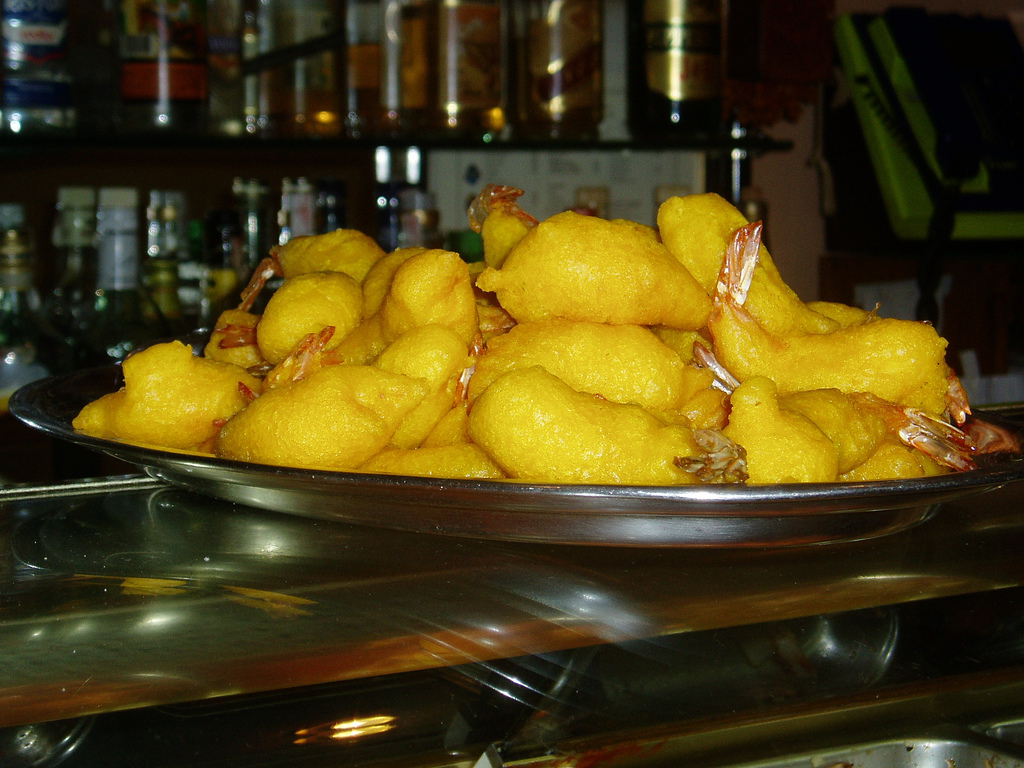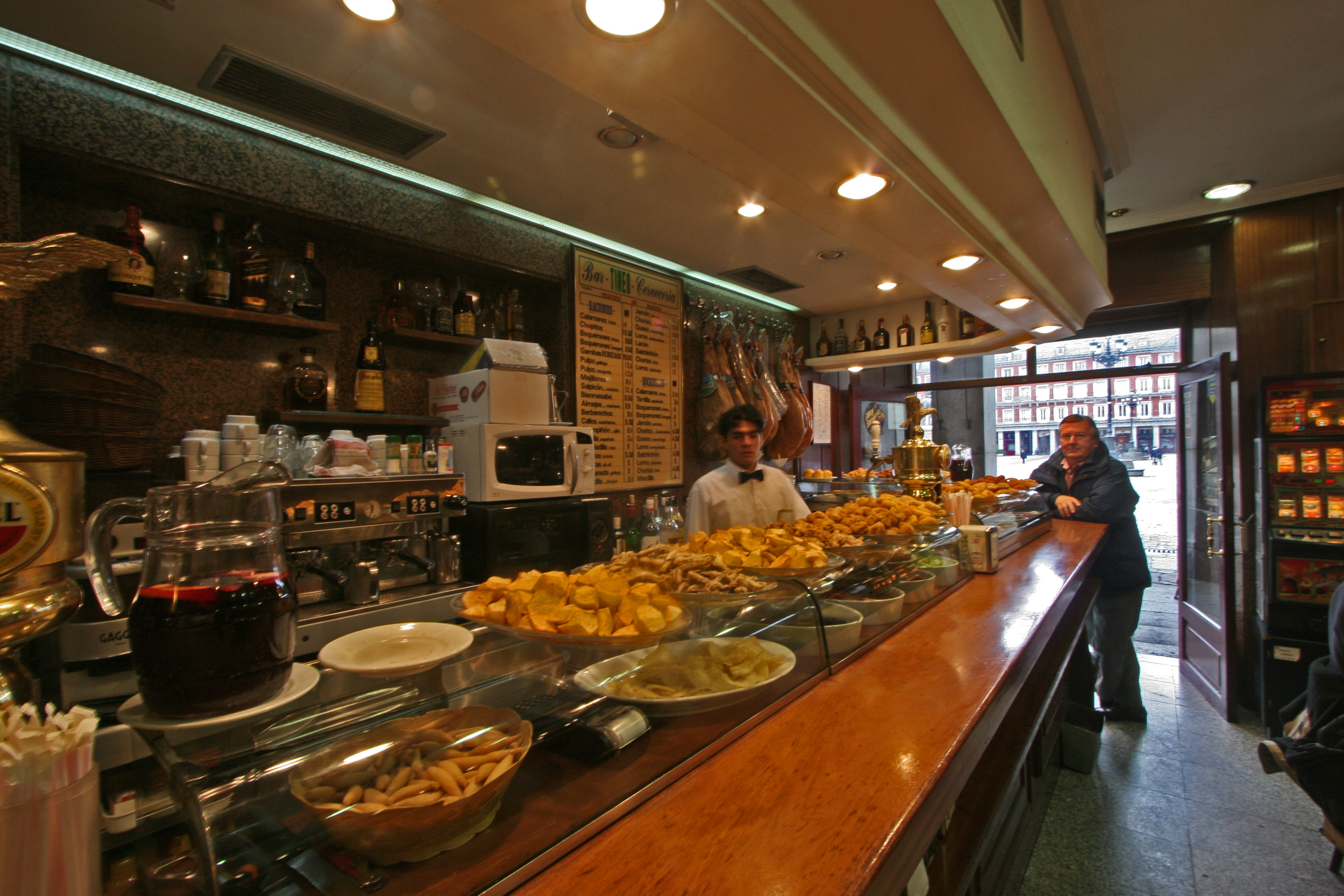|
Gambas Con Gabardina
''Gambas con gabardina'' (shrimp in a trenchcoat) is a popular Spain, Spanish Tapas, tapa that started to gain prominence in the 1950s, when it was included in the ''Manual de Cocina'', a cookbook published by the Sección Femenina and given to all Spanish housewives after they completed their Social Service, the female equivalent to conscription during the Francoist dictatorship. It consists of shrimp coated in a flour, egg, beer and cornstarch Batter (cooking), batter (known in French as à l'Orly) and then deep fried in olive oil. The tails are left during cooking as the shrimp is eaten by hand. The batter may have a yellow tint due to the use of saffron. The name of the dish comes from the way the batter covers the shrimp, as it does so in the fashion of a trenchcoat. A variant popular in Murcia is known as ''caballitos'' (seahorses), as the peeled shrimp takes the shape of this fish through the use of a toothpick which is then used to eat the snack. References {{reflist D ... [...More Info...] [...Related Items...] OR: [Wikipedia] [Google] [Baidu] |
Appetizer
An hors d'oeuvre ( ; french: hors-d'œuvre ), appetiser or starter is a small dish served before a meal in European cuisine. Some hors d'oeuvres are served cold, others hot. Hors d'oeuvres may be served at the dinner table as a part of the meal, or they may be served before seating, such as at a reception or cocktail party. Formerly, hors d'oeuvres were also served between courses.''Oxford English Dictionary'', First Edition, 189''s.v.''/ref> There are two types of hors d'oeuvre from service point of view: # General hors d'oeuvre # Classical hors d'oeuvre General hors d'oeuvres include cold preparations such as salad, cold meat, and fish. Classical hors d'oeuvres include fruit juice and soft drinks, grapefruit, shellfish cocktail, and so on. Typically smaller than a main dish, an hors d'oeuvre is often designed to be eaten by hand. Etymology in French literally means "outside the work"; that is, "not part of the ordinary set of courses in a meal". In practice, i ... [...More Info...] [...Related Items...] OR: [Wikipedia] [Google] [Baidu] |
Francoist Dictatorship
Francoist Spain ( es, España franquista), or the Francoist dictatorship (), was the period of Spanish history between 1939 and 1975, when Francisco Franco ruled Spain after the Spanish Civil War with the title . After his death in 1975, Spain transitioned into a democracy. During this time period, Spain was officially known as the Spanish State (). The nature of the regime evolved and changed during its existence. Months after the start of the Spanish Civil War in July 1936, Franco emerged as the dominant rebel military leader and was proclaimed head of state on 1 October 1936, ruling a dictatorship over the territory controlled by the Nationalist faction. The 1937 Unification Decree, which merged all parties supporting the rebel side, led to Nationalist Spain becoming a single-party regime under the FET y de las JONS. The end of the war in 1939 brought the extension of the Franco rule to the whole country and the exile of Republican institutions. The Francoist dictatorshi ... [...More Info...] [...Related Items...] OR: [Wikipedia] [Google] [Baidu] |
Shrimp Dishes
Shrimp are crustaceans (a form of shellfish) with elongated bodies and a primarily swimming mode of locomotion – most commonly Caridea and Dendrobranchiata of the decapod order, although some crustaceans outside of this order are referred to as "shrimp". More narrow definitions may be restricted to Caridea, to smaller species of either group or to only the marine species. Under a broader definition, ''shrimp'' may be synonymous with prawn, covering stalk-eyed swimming crustaceans with long, narrow muscular tails (abdomens), long whiskers ( antennae), and slender legs. Any small crustacean which resembles a shrimp tends to be called one. They swim forward by paddling with swimmerets on the underside of their abdomens, although their escape response is typically repeated flicks with the tail driving them backwards very quickly. Crabs and lobsters have strong walking legs, whereas shrimp have thin, fragile legs which they use primarily for perching.Rudloe & Rudloe (2009 ... [...More Info...] [...Related Items...] OR: [Wikipedia] [Google] [Baidu] |
Deep Fried Foods
Deep or The Deep may refer to: Places United States * Deep Creek (Appomattox River tributary), Virginia * Deep Creek (Great Salt Lake), Idaho and Utah * Deep Creek (Mahantango Creek tributary), Pennsylvania * Deep Creek (Mojave River tributary), California * Deep Creek (Pine Creek tributary), Pennsylvania * Deep Creek (Soque River tributary), Georgia * Deep Creek (Texas), a tributary of the Colorado River * Deep Creek (Washington), a tributary of the Spokane River * Deep River (Indiana), a tributary of the Little Calumet River * Deep River (Iowa), a minor tributary of the English River * Deep River (North Carolina) * Deep River (Washington), a minor tributary of the Columbia River * Deep Voll Brook, New Jersey, also known as Deep Brook Elsewhere * Deep Creek (Bahamas) * Deep Creek (Melbourne, Victoria), Australia, a tributary of the Maribyrnong River * Deep River (Western Australia) People * Deep (given name) * Deep (rapper), Punjabi rapper from Houston, Texas * Ravi Deep (b ... [...More Info...] [...Related Items...] OR: [Wikipedia] [Google] [Baidu] |
Trenchcoat
A trench coat or trenchcoat is a variety of coat made of waterproof heavy-duty fabric, originally developed for British Army officers before the First World War, and becoming popular while used in the trenches. Originally made from gabardine, a worsted wool fabric waterproofed using lanolin before weaving, the traditional colour of a trench coat was khaki. Traditionally trench coats are double-breasted with 10 front buttons, wide lapels, a storm flap, and pockets that button-close. The coat is belted at the waist with a self-belt, with raglan sleeves ending in cuff straps around the wrists that also buckle, to keep water from running down the forearm when using binoculars in the rain. The coat often has epaulets that button-close, which were functional in a military context. The trench coat was typically worn as a windbreaker or as a rain jacket, and not for sole protection from the cold in winter. Although many come with removable wool liners for additional warmth, they are ... [...More Info...] [...Related Items...] OR: [Wikipedia] [Google] [Baidu] |
Saffron
Saffron () is a spice derived from the flower of ''Crocus sativus'', commonly known as the "saffron crocus". The vivid crimson stigma and styles, called threads, are collected and dried for use mainly as a seasoning and colouring agent in food. Although some doubts remain on its origin, it is believed that saffron originated in Iran. However, Greece and Mesopotamia have also been suggested as the possible region of origin of this plant. Saffron crocus slowly propagated throughout much of Eurasia and was later brought to parts of North Africa, North America, and Oceania. Saffron's taste and iodoform-like or hay-like fragrance result from the phytochemicals picrocrocin and safranal. It also contains a carotenoid pigment, crocin, which imparts a rich golden-yellow hue to dishes and textiles. Its recorded history is attested in a 7th-century BC Assyrian botanical treatise, and has been traded and used for thousands of years. In the 21st century, Iran produces some 90% of ... [...More Info...] [...Related Items...] OR: [Wikipedia] [Google] [Baidu] |
Olive Oil
Olive oil is a liquid fat obtained from olives (the fruit of ''Olea europaea''; family Oleaceae), a traditional tree crop of the Mediterranean Basin, produced by pressing whole olives and extracting the oil. It is commonly used in cooking: for frying foods or as a salad dressing. It can be found in some cosmetics, pharmaceuticals, soaps, and fuels for traditional oil lamps. It also has additional uses in some religions. The olive is one of three core food plants in Mediterranean cuisine; the other two are wheat and grapes. Olive trees have been grown around the Mediterranean since the 8th millennium BC. In 2019–2020, world production of olive oil was . Spain was the largest producer followed by Italy, Tunisia, Greece, Turkey and Morocco. San Marino has by far the largest per capita consumption of olive oil worldwide. The composition of olive oil varies with the cultivar, altitude, time of harvest, and extraction process. It consists mainly of oleic acid (up to 83%), with ... [...More Info...] [...Related Items...] OR: [Wikipedia] [Google] [Baidu] |
Deep Fried
Deep frying (also referred to as deep fat frying) is a cooking method in which food is submerged in hot fat, traditionally lard but today most commonly oil, as opposed to the shallow oil used in conventional frying done in a frying pan. Normally, a deep fryer or chip pan is used for this; industrially, a pressure fryer or vacuum fryer may be used. Deep frying may also be performed using oil that is heated in a pot. Deep frying is classified as a hot-fat cooking method. Typically, deep frying foods cook quickly: all sides of the food are cooked simultaneously as oil has a high rate of heat conduction. The term "deep frying" and many modern deep-fried foods were not invented until the 19th century, but the practice has been around for millennia. Early records and cookbooks suggest that the practice began in certain European countries before other countries adopted the practice. Deep frying is popular worldwide, with deep-fried foods accounting for a large portion of global calor ... [...More Info...] [...Related Items...] OR: [Wikipedia] [Google] [Baidu] |
Shrimp
Shrimp are crustaceans (a form of shellfish) with elongated bodies and a primarily swimming mode of locomotion – most commonly Caridea and Dendrobranchiata of the decapod order, although some crustaceans outside of this order are referred to as "shrimp". More narrow definitions may be restricted to Caridea, to smaller species of either group or to only the marine species. Under a broader definition, ''shrimp'' may be synonymous with prawn, covering stalk-eyed swimming crustaceans with long, narrow muscular tails (abdomens), long whiskers ( antennae), and slender legs. Any small crustacean which resembles a shrimp tends to be called one. They swim forward by paddling with swimmerets on the underside of their abdomens, although their escape response is typically repeated flicks with the tail driving them backwards very quickly. Crabs and lobsters have strong walking legs, whereas shrimp have thin, fragile legs which they use primarily for perching.Rudloe & Rudloe (2009 ... [...More Info...] [...Related Items...] OR: [Wikipedia] [Google] [Baidu] |
Sección Femenina
The Sección Femenina ("Female Section"; SF) was the women's branch of the Falange political movement in Spain. Founded in July 1934 as part of the Sindicato Español Universitario (SEU) of the Falange Española de las JONS (FE de las JONS), and fully incorporated to FE de las JONS later in the year, it remained as part of the FET y de las JONS following the 1937 Unification Decree, subsequently becoming an official institution of the single-party of the Francoist dictatorship. Following General Franco's death and the beginning of the transition to democracy it was disbanded on 1 April 1977 together with all Movimiento Nacional institutions. Sección Femenina was led throughout its history by Pilar Primo de Rivera, the younger sister of Falange Española founder José Antonio Primo de Rivera. Sección Femenina in Francoist Spain were an important organization in defining Spanish womanhood. They were part of fascist organization Falange, with their ideology based on the teachin ... [...More Info...] [...Related Items...] OR: [Wikipedia] [Google] [Baidu] |
Spain
, image_flag = Bandera de España.svg , image_coat = Escudo de España (mazonado).svg , national_motto = ''Plus ultra'' (Latin)(English: "Further Beyond") , national_anthem = (English: "Royal March") , image_map = , map_caption = , image_map2 = , capital = Madrid , coordinates = , largest_city = Madrid , languages_type = Official language , languages = Spanish language, Spanish , ethnic_groups = , ethnic_groups_year = , ethnic_groups_ref = , religion = , religion_ref = , religion_year = 2020 , demonym = , government_type = Unitary state, Unitary Parliamentary system, parliamentary constitutional monarchy , leader_title1 = Monarchy of Spain, Monarch , leader_name1 = Felipe VI , leader_title2 = Prime Minister of Spain ... [...More Info...] [...Related Items...] OR: [Wikipedia] [Google] [Baidu] |
Tapas
A tapa () is an appetizer or snack in Spanish cuisine. Tapas can be combined to make a full meal, and can be cold (such as mixed olives and cheese) or hot (such as ''chopitos'', which are battered, fried baby squid, or patatas bravas). In some bars and restaurants in Spain and across the globe, tapas have evolved into a very sophisticated cuisine. In some Central American countries, such snacks are known as ''bocas''. In parts of Mexico, similar dishes are called ''botanas''. History The word "tapas" is derived from the Spanish verb ''tapar'', "to cover", a cognate of the English ''top''. In pre-19th-century Spain tapas were served by ''posadas'', ''albergues'' or ''bodegas'', offering meals and rooms for travellers. Since few innkeepers could write and few travellers read, inns offered their guests a sample of the dishes available, on a "tapa" (the word for pot cover in Spanish). According to ''Joy of Cooking'', the original tapas were thin slices of bread or meat wh ... [...More Info...] [...Related Items...] OR: [Wikipedia] [Google] [Baidu] |

_(2).jpg)






